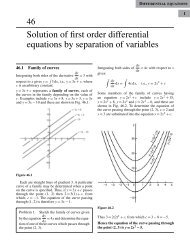differentiation
Create successful ePaper yourself
Turn your PDF publications into a flip-book with our unique Google optimized e-Paper software.
Differential calculus<br />
28<br />
Some applications of <strong>differentiation</strong><br />
28.1 Rates of change<br />
If a quantity y depends on and varies with a quantity<br />
x then the rate of change of y with respect to x is dy<br />
dx .<br />
Thus, for example, the rate of change of pressure p<br />
with height h is dp<br />
dh .<br />
A rate of change with respect to time is usually<br />
just called ‘the rate of change’, the ‘with respect to<br />
time’ being assumed. Thus, for example, a rate of<br />
change of current, i, is di<br />
dt<br />
temperature, θ, is dθ , and so on.<br />
dt<br />
and a rate of change of<br />
Problem 1. The length l metres of a certain<br />
metal rod at temperature θ ◦ C is given<br />
by l = 1 + 0.00005θ + 0.0000004θ 2 . Determine<br />
the rate of change of length, in mm/ ◦ C, when the<br />
temperature is (a) 100 ◦ C and (b) 400 ◦ C.<br />
The rate of change of length means dl<br />
dθ .<br />
Since length l = 1 + 0.00005θ + 0.0000004θ 2 ,<br />
then<br />
dl<br />
= 0.00005 + 0.0000008θ<br />
dθ<br />
(a) When θ = 100 ◦ C,<br />
dl<br />
dθ<br />
= 0.00005 + (0.0000008)(100)<br />
= 0.00013 m/ ◦ C<br />
= 0.13 mm/ ◦ C<br />
(b) When θ = 400 ◦ C,<br />
dl<br />
= 0.00005 + (0.0000008)(400)<br />
dθ<br />
= 0.00037 m/ ◦ C<br />
= 0.37 mm/ ◦ C<br />
Problem 2. The luminous intensity I candelas<br />
of a lamp at varying voltage V is given by<br />
I = 4 ×10 −4 V 2 . Determine the voltage at which<br />
the light is increasing at a rate of 0.6 candelas<br />
per volt.<br />
The rate of change of light with respect to voltage is<br />
given by dI<br />
dV .<br />
Since I = 4 × 10 −4 V 2 ,<br />
dI<br />
dV = (4 × 10−4 )(2)V = 8 × 10 −4 V<br />
When the light is increasing at 0.6 candelas per volt<br />
then +0.6 = 8 × 10 −4 V, from which, voltage<br />
V =<br />
0.6<br />
= 0.075 × 10+4<br />
8 × 10−4 = 750 volts<br />
Problem 3. Newtons law of cooling is given<br />
by θ = θ 0 e −kt , where the excess of temperature<br />
at zero time is θ0 ◦C and at time t seconds is θ◦ C.<br />
Determine the rate of change of temperature<br />
after 40 s, given that θ 0 = 16 ◦ C and k =−0.03.<br />
The rate of change of temperature is dθ<br />
dt .<br />
Since θ = θ 0 e −kt<br />
then<br />
dθ<br />
= (θ 0 )(−k)e −kt =−kθ 0 e −kt<br />
dt<br />
When θ 0 = 16, k =−0.03 and t = 40<br />
then<br />
dθ<br />
dt<br />
=−(−0.03)(16)e −(−0.03)(40)<br />
= 0.48e 1.2 = 1.594 ◦ C/s










